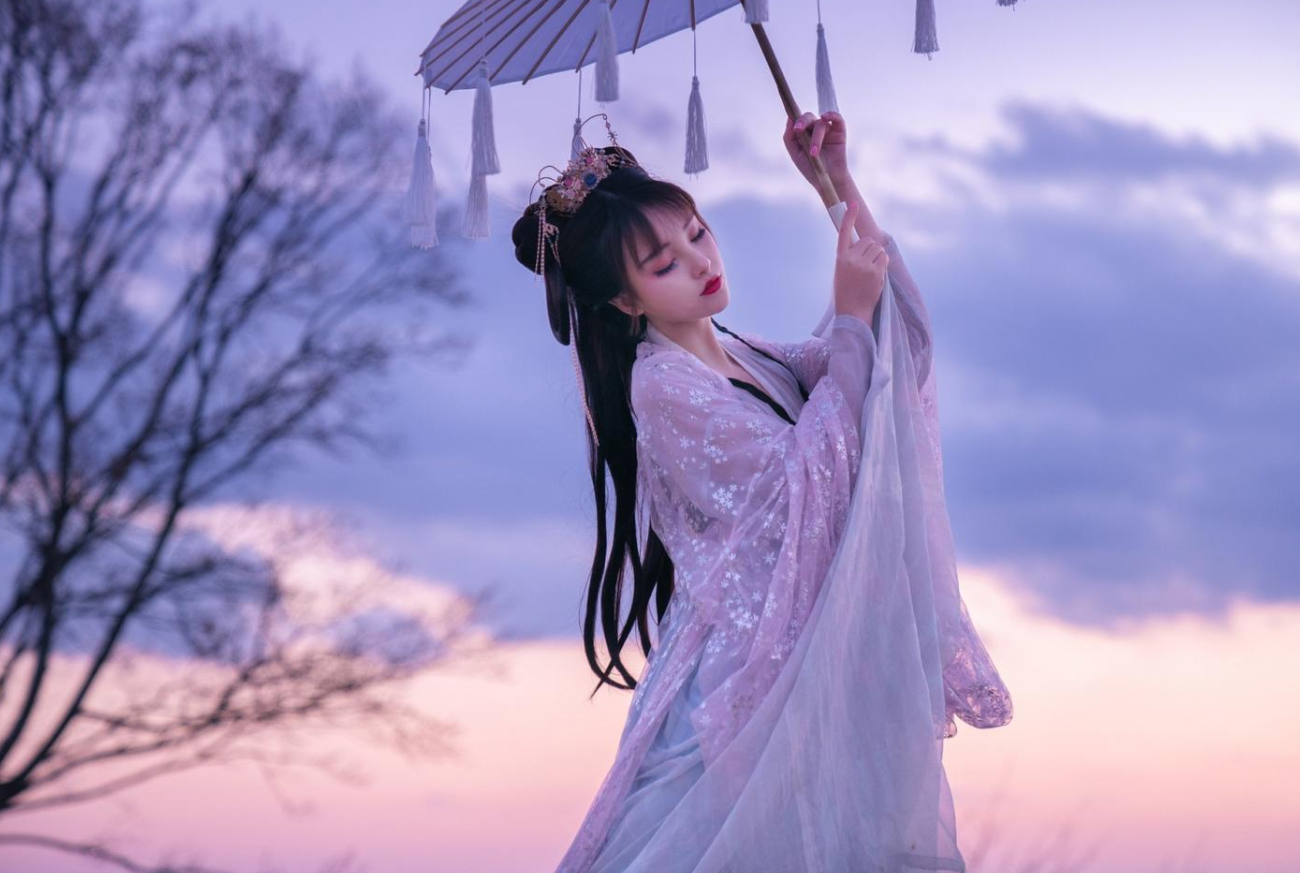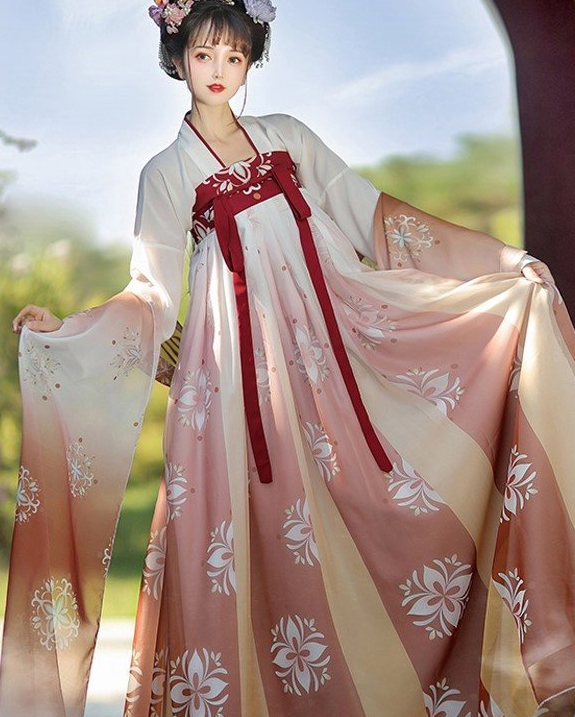Hanfu was developed by the Han Chinese during the Han dynasty.
Historical Origins of Hanfu
The Hanfu, an emblematic traditional Chinese garment, traces its roots back to the Han dynasty and even earlier. Its styles and components have evolved with the shifting sands of time, reflecting the socio-political and cultural changes across different Chinese dynasties.

The first recorded instances
Historical records indicate that the early forms of Hanfu can be linked to the three ancient Chinese dynasties: Xia, Shang, and Zhou. During the Zhou dynasty, detailed depictions of clothing began to emerge, providing us with a clearer understanding of its early styles. Ritual books and bronze inscriptions of this period provide depictions of the Hanfu’s design, helping us to reconstruct its appearance.
Dynastic evolution of Hanfu styles
- Qin and Han Dynasties: The Han dynasty played a pivotal role in the naming and popularization of the Hanfu. It was during this period that Hanfu became synonymous with daily wear. The styles were simple, elegant, and practical for both court officials and common folks.
- Tang Dynasty: The Tang dynasty was an era of prosperity and cultural exchange. The Hanfu during this period was influenced by foreign cultures due to the Silk Road, leading to more diversified and lavish styles.
- Song and Yuan Dynasties: The Hanfu observed during the Song dynasty was characterized by its layered looks and longer sleeves. However, during the Yuan dynasty, Mongolian influences started to merge with traditional Hanfu styles.
- Ming Dynasty: The Ming dynasty brought a resurgence in traditional Hanfu designs, emphasizing high collars and large sleeves. This was a deliberate move to distinguish Han culture from previous Mongol rule.
Key Figures in Hanfu History
The legacy of Hanfu cannot be discussed without mentioning the individuals who played a pivotal role in its promotion, evolution, and preservation. From emperors who set trends to scholars who documented the attire, the Hanfu’s history is intertwined with these key figures.
Important emperors and their influence
- Emperor Wu of Han: Often considered one of the greatest emperors in Chinese history, Emperor Wu heavily endorsed Han culture, and with it, the Hanfu. His reign solidified the Hanfu as a symbol of Han Chinese identity.
- Emperor Taizong of Tang: During the reign of Emperor Taizong, the Tang dynasty reached a zenith in cultural and economic achievements. Under his influence, Hanfu designs incorporated diverse cultural elements, making them more varied and opulent.
- Emperor Hongwu of Ming: As the founder of the Ming dynasty, Emperor Hongwu emphasized traditional Han values. This renewed emphasis rejuvenated Hanfu styles, reverting to classic designs and resisting foreign influences.
Historical texts and authors that mention Hanfu
- “Book of Han”: This historical text, written during the Eastern Han dynasty, provides one of the earliest comprehensive records of Chinese history, including references to the Hanfu and its significance.
- Zhang Heng: A renowned polymath of the Eastern Han dynasty, Zhang Heng wrote several poems and essays mentioning the Hanfu, reflecting its cultural and daily significance.
- Zhu Xi: The esteemed Song dynasty Confucian scholar, Zhu Xi, often referred to Hanfu in his writings. His references serve as valuable insights into the Hanfu’s role in rituals and ceremonies during the Song period.
Components and Styles of Hanfu
Hanfu, with its long and illustrious history, encapsulates a wide variety of components and styles. Not only does it change with each dynasty’s aesthetic preferences, but regional differences also play a significant role in the variations of Hanfu designs.
Various components: robes, belts, hats, etc.
- Robes (Yi): Serving as the primary garment, robes can be single-layered for summer or multi-layered for colder seasons. They are typically cross-collared and tied with a sash.
- Belts (Dai): Beyond their functional use, belts also carry decorative significance. Crafted from silk, cloth, or leather, they often feature intricate designs and sometimes include pendant accessories.
- Hats (Mao): Used primarily for formal occasions, Chinese hats vary based on the wearer’s rank and status. They can range from simple cloth caps to elaborate headdresses with ornamental designs.
- Skirts (Chang): Worn by both men and women in ancient times, skirts have pleated designs and are paired with robes to create a harmonious ensemble.
- Shoes (Lü): Traditionally made from cloth or silk, Hanfu shoes are embroidered with patterns and complement the overall attire.
Differences across regions and dynasties
- Northern Styles: Influenced by the colder climate, northern Hanfu often featured thicker fabrics and multi-layered robes. The styles were more modest, and darker colors were prevalent.
- Southern Styles: Lighter fabrics like silk dominated the south. Here, Hanfu displayed brighter colors and more intricate embroidery, reflecting the region’s artistic inclinations.
- Tang Dynasty Variations: The flourishing Tang dynasty introduced a myriad of Hanfu styles. Influenced by foreign cultures, the Tang dynasty’s Hanfu embraced wider sleeves, vibrant colors, and elevated waistlines.
- Ming Dynasty Revisions: The Ming dynasty witnessed a return to traditional designs with a preference for straight collars and narrow sleeves.
Cultural Significance
Hanfu is more than just clothing; it embodies the values, philosophies, and aesthetics of Chinese culture.
Hanfu in rituals and ceremonies
- Confucian Ceremonies: Hanfu holds a central place in Confucian rites. The “Ji Yi” or sacrificial rites, which honor ancestors and deities, necessitate specific Hanfu attire. Each element, from the color of the robe to the design of the hat, is meticulously chosen to reflect respect and veneration.
- Weddings: Traditional Chinese weddings often feature the bride and groom in Hanfu. The attire signifies purity, luck, and prosperity. Often, the couple wears red Hanfu, a color associated with joy and good fortune.
- Funerals: Hanfu worn during funerals usually leans towards muted colors, especially white. It symbolizes grief, respect, and the impermanence of life.

Symbolism and meanings of different patterns and colors
- Dragons: A revered creature in Chinese mythology, the dragon often adorns Hanfu, symbolizing power, strength, and good fortune.
- Phoenix: Representing grace and virtue, the phoenix is a frequent motif, especially in women’s Hanfu. It embodies rebirth and the eternal cycle of life.
- Colors: Different colors in Hanfu bear varied meanings. For instance, red represents happiness and prosperity, blue stands for immortality, while black indicates the universe and its mysteries.
- Clouds: Often seen on the borders of Hanfu robes, clouds symbolize the heavens and the transcendence of mortal life.
- Bamboo: This resilient plant represents uprightness and integrity, a tribute to the Confucian virtues of honesty and moral rectitude.
Modern Revival of Hanfu
The winds of time cannot diminish the allure of Hanfu. While its ubiquity faded for a while, the 21st century has witnessed a spirited revival of this traditional attire. Today’s generation, seeking connections to their roots amid rapid modernization, has embraced Hanfu with an enthusiasm reminiscent of its ancient glory.
The 21st-century resurgence
The dawn of the 21st century marked a renewed interest in Hanfu, especially among the youth.
- Cultural Renaissance: As China’s global stature grew, there was a collective endeavor to reconnect with traditional roots, leading to a broader appreciation of cultural symbols like Hanfu.
- Social Media and Online Communities: Platforms like Weibo and TikTok witnessed young influencers donning Hanfu, sparking widespread interest. Online communities dedicated to Hanfu history, designs, and styling tips further fueled the revival.
- Television and Cinema: Historical dramas set in ancient dynasties, with their visually stunning depictions of characters in Hanfu, have captured the imagination of millions, reigniting a passion for traditional attire.
Popular figures and events promoting Hanfu today
- Influencers and Bloggers: Many Chinese influencers have become Hanfu ambassadors, regularly showcasing various styles and designs on their platforms. Their reach and impact have been instrumental in popularizing Hanfu among urban youth.
- Hanfu Festivals: Across cities in China, Hanfu festivals are organized where enthusiasts gather to display their attire, participate in traditional games, and immerse themselves in ancient Chinese culture.
- Fashion Shows: Modern reinterpretations of Hanfu are now showcased on prominent fashion runways, seamlessly blending tradition with contemporary designs.
- Celebrities: Renowned figures in the entertainment industry, from actors to singers, have embraced Hanfu, either in their performances, public appearances, or photoshoots, further elevating its modern appeal.







